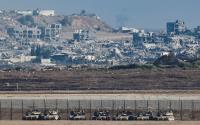PARIS -- Emissions of greenhouse gases will rise by 57 percent by 2030 compared to current levels, leading to a rise in Earth's surface temperature of at least three degrees Celsius (5.4 degrees Fahrenheit), the International Energy Agency (IEA) said on Wednesday.
In its annual report on global energy needs, the Paris-based agency projected greenhouse-gas pollution would rise by 1.8 percent annually by 2030 on the basis of projected energy use and current efforts to mitigate emissions.
The IEA saw scant chance of bringing this pollution down to a stable, safer level any time soon.
It poured cold water on a scenario sketched earlier this year by the Nobel-winning Intergovernmental Panel on Climate Change (IPCC), the UN's paramount authority on global warming and its effects.
The IPCC said that to limit the average increase in global temperatures to 2.4 C (4.3 F) -- the most optimistic of any of its scenarios -- the concentration of greenhouse gases would have to stabilize at 450 parts per million (ppm) of carbon dioxide (CO2) in the atmosphere.
The IPCC warned that, to achieve this goal, CO2 emissions would have to peak by 2015 at the latest and then fall between 50 and 85 percent by 2050.
But the 2007 edition of the IEA's World Energy Outlook saw no peak in emissions before 2020.
To achieve the 450ppm target would mean that CO2 from energy sources would have to peak by 2012, and this would require a massive drive in energy efficiency and switch to non-fossil fuels, the report said.
"Emissions savings (would have to) come from improved efficiency in fossil-fuel use in industry, buildings and transport, switching to nuclear power and renewables, and the widespread deployment of CO2 capture and storage in power generation and industry," the IEA said.
"Exceptionally quick and vigorous action by all countries and unprecedented technological advances, entailing, substantial costs, would be needed to make this case a reality."
Under the IEA's most optimistic scenario, which takes into account measures that are currently in the planning stage for tackling emissions, greenhouse-gas pollution would rise by one percent per year, rather than 1.8 percent on present trends.
Emissions would decline steadily beyond 2030, translating into an eventual rise in temperatures of "about" three C (5.4 F), IEA analyst Trevor Morgan said.
In contrast, under the IEA's most pessimistic scenario, warming could reach six C (10.8 F) if China and India continue their strong growth relentlessly, using coal as a principal energy source.
By 2030, the biggest polluters would be China, the United States, India, Russia and Japan, the IEA said.
In a massive report issued this year, the IPCC said that since 1900, the mean global atmospheric temperature had risen by 0.8 C (1.44 F) and levels of CO2, which account for about three-quarters of greenhouse-gas output, are now at their highest in 650,000 years.
This temperature rise has already caused glaciers, snow and ice cover to fall back sharply in alpine regions, reduced the scope of Arctic sea ice and caused Siberian and Canadian permafrost to retreat.
By 2100, global average surface temperatures could rise by between 1.1 C (1.98 F) and 6.4 C (11.52 F) compared to 1980-99 levels, the IPCC said.
Heatwaves, flooding, drought, tropical storms and surges in sea level are among the events expected to become more frequent, more widespread and/or more intense this century, the scientists said.
|






